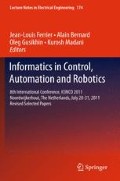Abstract
Currently most car drivers use static routing algorithms based on the shortest distance between start and end position. But the shortest route is different from the fastest route in time. Because existing routing algorithms lack the ability to react to dynamic changes in the road network, drivers are not optimally routed. The current traffic situation can be assessed by tracking car drivers provided with a smart GPS device. The real challenge is to predict future delays in travelling time. In this paper we present a multi-agent approach for routing vehicle drivers using historically-based traffic information. we successfully implemented a working prototype that uses various technologies such as Java, the Open Street Map API for rendering the map or J2ME for the mobile phone client.
Access this chapter
Tax calculation will be finalised at checkout
Purchases are for personal use only
Preview
Unable to display preview. Download preview PDF.
References
Kerner, B.S.: The Physics of Traffic. Springer (2004)
Wardrop, J.: Some theoretical aspects of road traffic research. In: Proceedings of the Institution of Civil Engineers, Part II, vol. 1(36), pp. 352–362 (1952)
Fisk, C.: More paradoxes in the equilibrium assignment problem. Transportation Research Part B: Methodological 13(4), 305–309 (1979)
Dantzig, G.B.: Discrete-variable extremum problems. Operations Res. 5, 266–277 (1957)
Dijkstra, E.W.: A note on two problems in connexion with graphs. Numer. Math. 1, 269–271 (1959)
Matsoukis, E.C.: Road traffic assignment, a review, part 1: non-equilibrium methods. Transportation Planning and Technology 11(1), 69–79 (1986)
Merchant, D.K., Nemhauser, G.L.: A model and an algorithm for the dynamic traffic assignment problems. Transportation Science 12(3), 183–199 (1978)
Ziliaskopoulos, A.K.: A linear programming model for the single destination system optimum dynamic traffic assignment problem. Transportation Science 34(1), 37–49 (2000)
Ho, J.K.: A successive linear optimization approach to the dynamic traffic assignment problem. Transportation Science 14(4), 295–305 (1980)
Friesz, T.L., Luque, J., Tobin, R.L., Wie, B.W.: Dynamic network traffic assignment considered as a continuous time optimal control problem. Operations Research 37(6), 893–901 (1989)
Vliet, Hall, M.V., Willumsen, D.: Saturn - a simulation assignment model for the evaluation of traffic management schemes. Traffic Engineering and Control 21(4), 168–176 (1980)
Taylor, N.B.: Contram dynamic traffic assignment model. Networks and Spatial Economics, 297–322 (1980)
Abdelfatah, A., Mahmassani, H.: A simulation-based signal optimization algorithm within a dynamic traffic assignment framework. In: Proceedings of 2001 IEEE Intelligent Transportation Systems, pp. 428–433 (2001)
Lum, K.M., Fan, H.S.L., Lam, S.H., Olszewski, P.: Speed-flow modeling of arterial roads in Singapore. Journal of Transportation Engineering 124(3), 213–222 (1998)
Kisgy, L., Rilett, L.R.: Travel time prediction by advanced neural network. Periodica Polytechnica Ser. Civ. Eng. 46 (2002)
Hobeika, A., Kim, C.K.: Traffic flow-prediction systems based on upstream traffic, pp. 345–350 (1994)
Li, Y., McDonald, M.: Link travel time estimation using single GPS-equipped probe vehicle, pp. 932–937 (2002)
Ishak, S., Al-Deek, H.: Performance evaluation of short-term time-series traffic prediction model. Journal of Transportation Engineering 128(6), 490–498 (2002)
Yu, J., Chang, G.-L., Ho, H., Liu, Y.: Variation based online travel time prediction using clustered neural networks (2008)
Lint, J., van Hoogendoorn, S., van Zuylen, H.: Accurate freeway travel time prediction with state-space neural networks under missing data. Transportation Research Part C: Emerging Technologies 13(5-6), 347–369 (2005)
Author information
Authors and Affiliations
Editor information
Editors and Affiliations
Rights and permissions
Copyright information
© 2013 Springer-Verlag Berlin Heidelberg
About this chapter
Cite this chapter
Radu, A., Rothkrantz, L., Novak, M. (2013). Digital Traveler Assistant. In: Ferrier, JL., Bernard, A., Gusikhin, O., Madani, K. (eds) Informatics in Control, Automation and Robotics. Lecture Notes in Electrical Engineering, vol 174. Springer, Berlin, Heidelberg. https://doi.org/10.1007/978-3-642-31353-0_8
Download citation
DOI: https://doi.org/10.1007/978-3-642-31353-0_8
Publisher Name: Springer, Berlin, Heidelberg
Print ISBN: 978-3-642-31352-3
Online ISBN: 978-3-642-31353-0
eBook Packages: EngineeringEngineering (R0)

